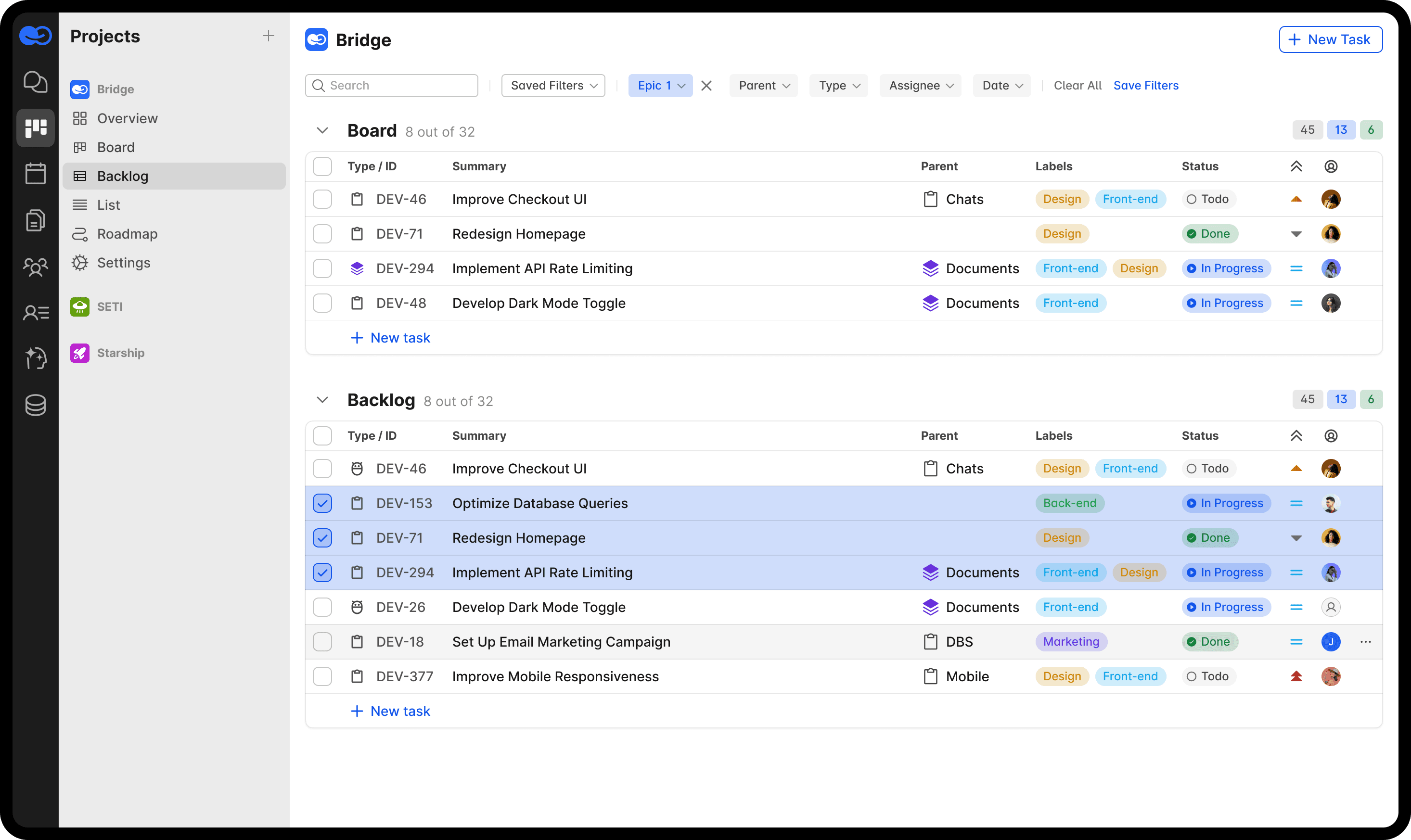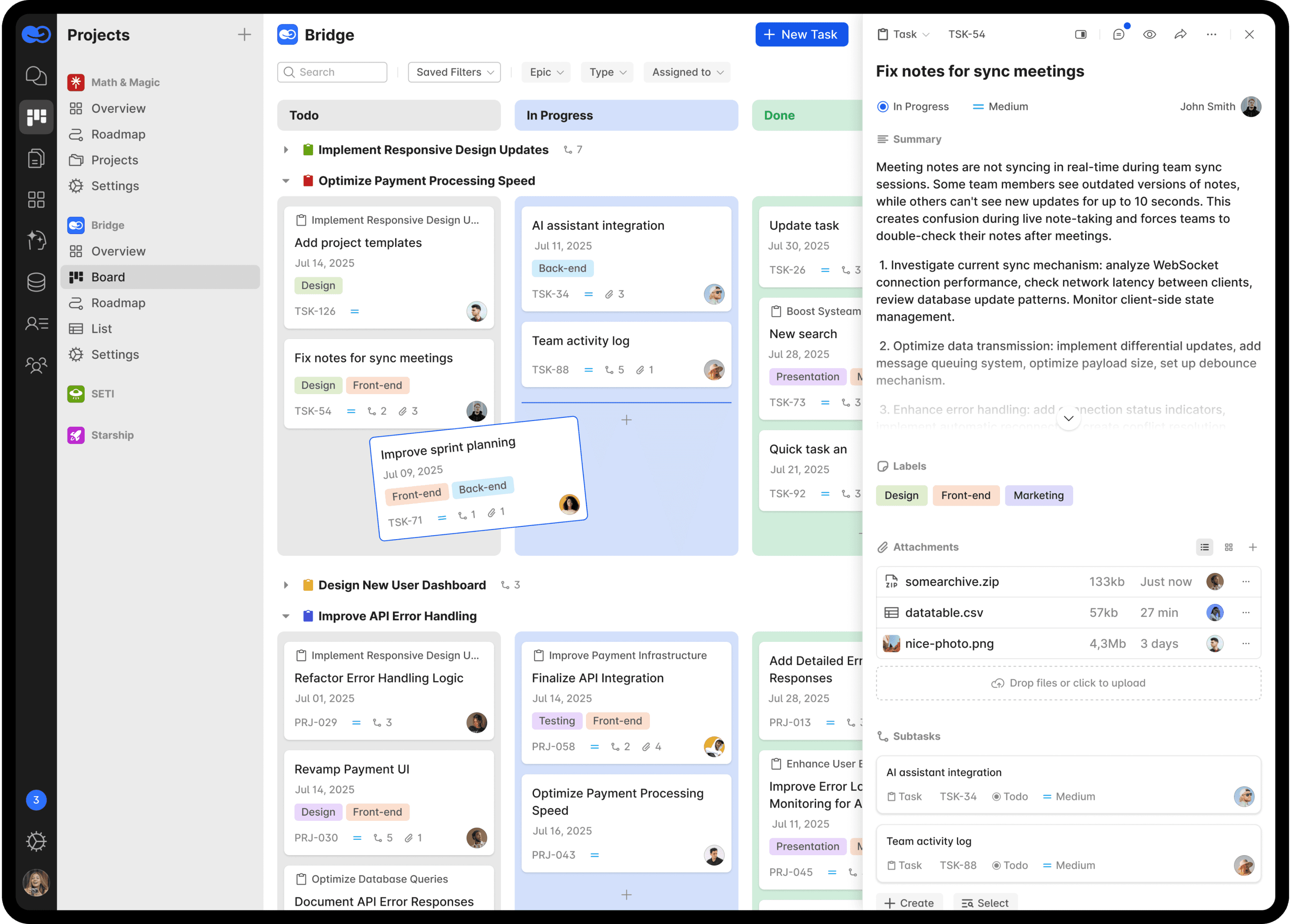The Complete Guide to Agile Methodology for Teams of Any Size

Agile methodology isn’t just for startups or software giants. It’s a scalable, flexible approach that empowers teams of any size to deliver faster, collaborate better, and continuously improve. In this guide, we’ll walk through the principles, frameworks, and practical steps you can take to implement agile and how Bridge, a smart digital workspace for modern teams, helps you do it better with a unified platform that adapts to your team’s needs.
Why Agile Methodology Matters for Every Team?
Agile adoption is growing rapidly. According to PMI, 71% of organizations use agile approaches sometimes, often, or always. Agile teams report 30-50% faster time-to-market and improved team morale. Many organizations are racing to become agile. New research suggests that agile transformation can have a powerful impact on the bottom line, in addition to other widely recognized benefits, McKinsey says.

But many still think agile is only for tech giants. That’s a myth. Whether you’re a 5-person startup or a 500-person enterprise, agile brings structure, visibility, and adaptability.
This guide is designed to help you:
- Understand core agile principles
- Choose the right framework (Scrum, Kanban, or hybrid)
- Implement agile in teams of any size
- Leverage Bridge to support your agile transformation
Let’s dive in.
Understanding Agile Methodology: Core Principles and Values
At the heart of agile is the Agile Manifesto:
"Individuals and interactions over processes and tools. Working software over comprehensive documentation. Customer collaboration over contract negotiation. Responding to change over following a plan."
These values are supported by 12 principles, such as delivering working solutions frequently, welcoming changing requirements, and empowering motivated teams.
Agile differs from traditional (waterfall) models by being iterative, collaborative, and flexible. It encourages ongoing feedback, shorter development cycles, and adaptive planning.
Common misconceptions include:
- "Agile means no planning" (false: planning is continuous)
- "Agile is only for developers" (false: it’s cross-functional)
- "Agile is chaotic" (false: agile is structured flexibility)
Agile Frameworks: Scrum, Kanban, and Hybrid Approaches
Scrum Framework
Scrum is the most widely adopted agile framework. It involves:
Roles:
- Product Owner
- Scrum Master
- Development Team
Events:
- Sprint Planning
- Daily Standups
- Sprint Review
- Sprint Retrospective
Artifacts:
- Product Backlog
- Sprint Backlog
- Increment
Scrum focuses on delivering value in short sprints (1-4 weeks).

Kanban Method
Kanban visualizes work using boards and cards, limiting work in progress (WIP) to ensure flow:
- Visual Workflow: Columns like To Do, In Progress, Done
- Continuous Delivery: No fixed sprints
- Flexibility: Great for service-oriented teams
Hybrid Approaches
Scrumban, a hybrid of Scrum and Kanban, blends the structure of Scrum with the flow of Kanban. Use a hybrid when:
- Teams need both flexibility and cadence
- You’re transitioning from one model to another
Implementing Agile for Small Teams (2-10 people)
Small teams benefit from lean agile setups. Here’s how:
- Simplified Roles: One person may wear multiple hats
- Flexible Sprints: Adjust lengths to fit team capacity
- Minimal Ceremonies: Focus on value, not formality
Common challenges:
- Lack of a dedicated Scrum Master
- Knowledge silos
Bridge in Action: Small teams use Bridge’s Kanban view to visualize work, limit WIP, and maintain focus. Quick drag-and-drop cards make task movement easy, while built-in chat keeps context.
Scaling Agile for Medium Teams (11-50 people)
Medium-sized teams require coordination across multiple units.
- Multiple Scrum Teams: Each with its own PO and SM
- Scrum of Scrums: Align cross-team work
- Shared Backlogs: Ensure transparency and alignment
Communication is key. Tools must support cross-team planning.
Bridge in Action: Teams use Bridge’s Backlog view to manage epics, stories, and priorities across squads. Shared views make coordination easy.
Enterprise Agile for Large Organizations (50+ people)
For enterprises, agile requires structured scaling:
- SAFe (Scaled Agile Framework): Manages portfolios and multiple product lines
- Agile Release Trains (ARTs): Align teams to common goals
- Executive Reporting: Ensures visibility across the team
Bridge in Action: With Bridge’s List View, you get intuitive filtering and in‑place task editing for streamlined workflows. This tool allows you to update every key field directly within the list view — no separate windows are required. All changes happen on the spot, minimizing clicks and saving time for the workflow.

For only €16/user/month on an annual commitment, your team can move to the Enterprise tier and gain the full enterprise arsenal: custom white‑labeling, a personal account manager, priority support channels, guaranteed uptime SLAs, the ability to bring your encryption keys (BYOK), and enhanced security governance.
Essential Agile Tools and Bridge’s Solution
Traditional Toolset
Agile typically requires several tools:
- Project Management (e.g. Jira)
- Communication (e.g. Slack)
- Docs (e.g. Confluence)
- Reporting (e.g. Tableau)
Bridge Unifies It All
Bridge integrates:
- Backlog View: Drag-and-drop prioritization, story points, AI insights
- Kanban View: Custom columns, WIP limits, visual flow
- List View: Task filtering, progress tracking, reporting
- AI Features: Smart planning, predictive analytics, automated burndown charts
- Comms & Docs: Everything in one workspace
Creating and Managing Product Backlogs
Backlogs are the heart of agile. To manage them well:
- Write clear user stories (As a [role], I want [feature] so that [benefit])
- Estimate stories with Planning Poker or T-shirt sizing
- Prioritize using MoSCoW or Kano model
- Refine regularly (grooming sessions)
Bridge Highlight: AI-assisted backlog prioritization surfaces what matters most based on past data and team capacity.
Sprint Planning and Execution
Planning is everything. Use this structure:
- Review prioritized backlog
- Estimate capacity (story points, velocity)
- Select the sprint goal and scope
Daily standups keep the sprint on track. Scope creep? Use timeboxing and clear definitions of done.
Bridge Highlight: AI suggests optimal sprint scope based on team history.
Common Agile Challenges and Solutions
Challenge: Resistance to change
Solution: Start with one team, show wins
Challenge: Incomplete stories
Solution: Use acceptance criteria templates
Challenge: Remote coordination
Solution: Use unified tools like Bridge
Bridge addresses all major pain points with built-in comms, AI, and centralized views.
Getting Started: Your Agile Implementation Roadmap
Not sure where to begin? Follow this 30-60-90 day plan:
Day 0-30:
- Agile training
- Set initial backlog
- Launch Bridge with 1 team
Day 31-60:
- Start 2-week sprints
- Conduct retrospectives
- Expand to 2-3 teams
Day 61-90:
- Add executive reporting
- Use AI analytics
- Track velocity trends
Ready to implement agile methodology? Start your free Bridge trial and experience agile project management with backlog, kanban, and list views.


